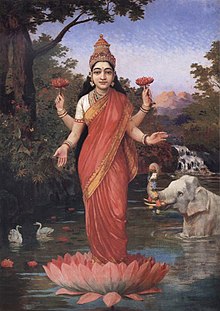Saree (clothing)


The sari ( Hindi , f., साड़ी, sāṛī, English also saree ), which is native to South Asia , is a sewn wrap skirt with one-sided shoulder wrap for women. The sari is an example of a traditional garment ( dress ) that in India, Sri Lanka , Bangladesh , Nepal and even in some areas of Pakistan today very often in everyday lifewill be carried; there are also holiday saris. There are numerous ways to wear a sari; these differ depending on the respective cultural area, so that the origin of the wearer can also be recognized by the way in which the clothes are worn. In Gujarat, for example, the end of the sari doesn't hang down at the back, but at the front. There are also wearing styles that are subject to change over time (see Lehanga ).
description
The sari consists of an approx. 0.80–1.20 m wide and approx. 5–6 m (in extreme cases up to 9 m) long, rectangularly woven and above all seamless cloth that is attached to the sides and / or the Often ends with a more or less wide decorative braid of a different color. This fabric can be generally divided into three zones, the Paluv (also Pallu ), the thrown mostly over the left shoulder shoulder piece which is designed most decorative, then the body (skirt) of the Saris, the be both simple and executed very decor rich can, and the final decorative border on the hem.
In earlier times, the length of fabric, mostly made of white cotton fabric (see the dress of the Missionaries of Charity ), was the only item of clothing for women. Today an underskirt is sometimes worn underneath; the upper body is protected from prying eyes by a tight, mostly short-sleeved and belly-free, buttoned-up bodice called choli (चोली, colī). Both are, however, mainly modern traditions and - apart from a few early Indian examples - very likely go back to Arab, but also European, mainly British , influences or arrangements. In some (semi) transparent holiday saris, the choli has been significantly reduced in size since the last decades of the 20th century or replaced by a bra - naturally strapless .
material
Saris are traditionally made from cotton because this material is comparatively cheap and easy to produce. Saris for festive occasions or high-ranking personalities are traditionally made of silk , which is much more complex and expensive to produce. Because of the high cost of the fabric, silk saris are mainly worn by women of the wealthy middle and upper classes . Today saris are often mass-produced from a mixture of the synthetic material polyester with cotton and / or silk.
Others
- Sari skin cancer . A rare form of skin cancer caused by constant skin irritation from the saree on the wearer's hips.
- Pink saris . A documentary by Kim Longinotto about the work of the Indian activist Sampat Pal Devi and the so-called Gulabi Gang in the northern Indian state of Uttar Pradesh .

See also
Wrap skirts without a shoulder wrap (but sometimes with a choli jacket) can be found on the female figures of
The oldest depictions of saris with shoulder straps can be found in the miniature paintings of the pre-Mughal and Mughal times .
literature
- Maria Blechmann-Antweiler: Saris. Catalog for the exhibition in Trier University Library, Trier 2007, Matergloriosa, ISBN 978-3-9811323-7-3
- Martand Singh: Sari - the most beautiful dress in the world. Cologne 2012. ISBN 978-3-8321-9458-1


